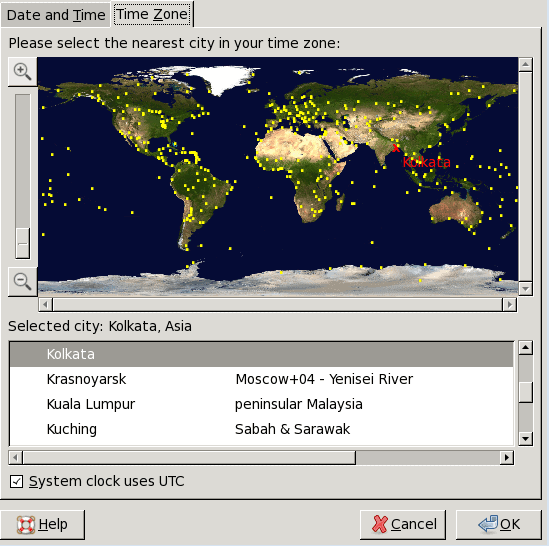Timezone configuration on Linux is usually set up at installation time. On RHEL 5 and 6, the procedure to change the Timezone configuration is as follows. The example used here is from timezone MDT to IST. The timezone can be either changed from command line or using the system-config-date command.
Using system-config-date command
Use the system-config-date graphical utility:
# system-config-date
In case the command is not available, install the required package with yum :
# yum install system-config-date
Use the system-config-date graphical tool to set the required timezone from a list of timezones as shown below.

Using the command line
1. Check the file /etc/sysconfig/clock and the date command output to confirm the current timezone set.
# cat /etc/sysconfig/clock ZONE="America/Denver"
# date Wed May 17 13:41:16 MDT 2017
2. Navigate to the directory /usr/share/zoneinfo and check the available files. (Each file represents a timezone). Find the file representing the timezone to be configured.
# cd /usr/share/zoneinfo [root@VOM-VCS-MONITOR zoneinfo]# ls -l total 296 drwxr-xr-x. 2 root root 4096 Aug 15 2014 Africa drwxr-xr-x. 6 root root 4096 Aug 15 2014 America drwxr-xr-x. 2 root root 4096 Aug 15 2014 Antarctica drwxr-xr-x. 2 root root 4096 Aug 15 2014 Arctic drwxr-xr-x. 2 root root 4096 Aug 15 2014 Asia drwxr-xr-x. 2 root root 4096 Aug 15 2014 Atlantic drwxr-xr-x. 2 root root 4096 Aug 15 2014 Australia drwxr-xr-x. 2 root root 4096 Aug 15 2014 Brazil drwxr-xr-x. 2 root root 4096 Aug 15 2014 Canada ......
3. Replace the value on /etc/sysconfig/clock with the path to that file starting from /usr/share/zoneinfo. For example, if the target timezone is IST time for India. The file under /usr/share/zoneinfo representing that timezone is:
/etc/share/zoneinfo/Asia/Kolkata
Therefore, change /etc/sysconfig/clock file so it reads:
ZONE="Asia/Kolkata"
4. Replace /etc/localtime with the appropriate zone file by reading /etc/sysconfig/clock using this command:
# tzdata-update
Verify
You can verify the change of timezone by “date” command and checking the /etc/sysconfig/clock file as shown below.
# cat /etc/sysconfig/clock ZONE="Asia/Kolkata"
# date Wed May 17 15:30:22 IST 2017
CentOS / RHEL : Using yum to download a package without installing it
Configuring a different timezone for individual users
To configure a different time zone from the system-wide default for an individual user, add the following line to the .bashrc in that user’s home directory:
export TZ="/usr/share/zoneinfo/[timezone_directory]/[timezone_file]"
In the above directive, replace [timezone_directory] with a time zone directory in the /usr/share/zoneinfo/ directory, such as US, and replace [timezone_file] with a time zone file within that time zone directory, such as Eastern. It is possible to reference any file within the /usr/share/zoneinfo/ directory for valid values.